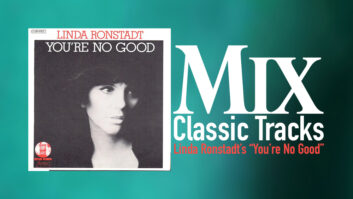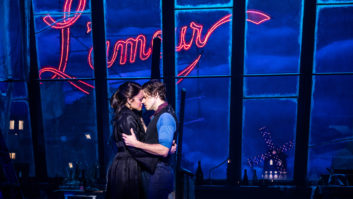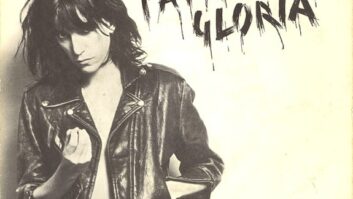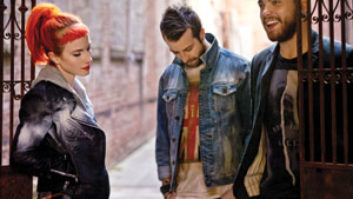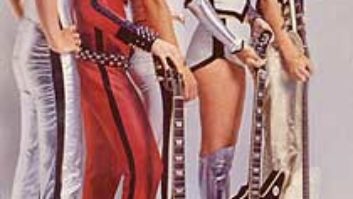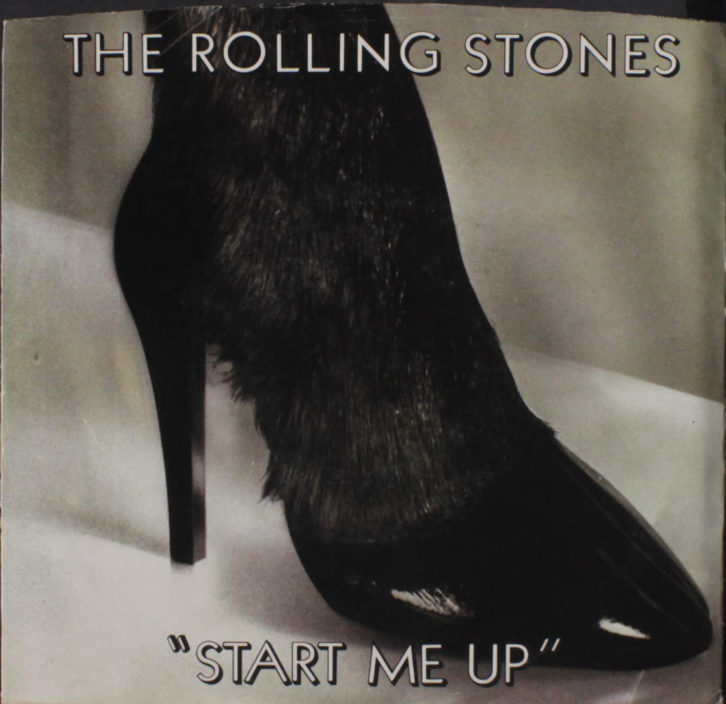
The 1970s was a schizophrenic decade for the Rolling Stones. Their 1971 release Sticky Fingers, cut in Muscle Shoals, was one of their best records ever, clear evidence that with The Beatles broken up beyond repair, the Stones truly were the greatest rock band in the world. They staged a triumphant tour the following year, and released the dense, murky masterpiece Exile on Main Street, recorded mostly at Keith Richards’ villa in the south of France. But all was not well in Stones land — Keith developed a nasty heroin habit, guitarist Mick Taylor (who’d replaced original member Brian Jones, who died in a swimming pool mishap) was increasingly on the outs with his mates, and Mick Jagger had come to embrace the lifestyle of an international jet-setter, hanging out with the rich and beautiful people in various European and American cities, much to Keith’s dismay. The group’s mid-’70s recordings lack some of the focus of the group’s best work, though certainly there are nuggets to be found on Goat’s Head Soup (1973), It’s Only Rock ‘n’ Roll (1974) and, especially, Black and Blue (1976; it’s the first Stones record to feature ex-Faces guitarist Ron Wood). And though none of those records achieved the commercial stature of Sticky Fingers, each hit Number One in the U.S. and Britain — proof of the band’s amazing power and appeal, even when they were mainly coasting.
The group’s next creative triumph was just around the corner, however. Some Girls, released in June 1978, was a return to form — a hard-rocking, ass-kicking album that showed the Stones were still at the top of their game and not ready to be dismissed as irrelevant dinosaurs in the age of punk and new wave. Okay, the album’s first big hit single, “Miss You,” was more New York disco than London buzz-saw punk, but the album as a whole was full of raw energy and vitality. The sessions for Some Girls, too, produced this month’s Classic Track, “Start Me Up” — though the finished song didn’t appear on a Stones album until 1981 on Tattoo You.
By the time the sessions for Some Girls came around, the Stones were emerging from their mid-decade malaise. Keith Richards had been busted for heroin possession in Toronto during 1977 and made a sincere effort to clean up his act. Ron Wood was fitting in well with the group; he was a marvelous musical foil for Keith, and his puckish spirit made him a good fit. Mick had all but extricated himself from his troubled marriage to his Nicaraguan socialite wife, Bianca, and was happily on the prowl again. And there’s no question that The Clash and the Sex Pistols and the other great bands who emerged from the London and New York undergrounds in ’76 and ’77 really did light a fire under the Stones; after all, the Stones were the spiritual ancestors of many of those bands, before the decadence and ennui crept in.
Mostly for tax reasons, the Stones had taken to recording outside of England whenever possible — Goats Head Soup was cut mainly in Jamaica, Black and Blue in Munich — and the plan for the album that became Some Girls was to write songs in a giant rehearsal room in Paris’ Pathé Marconi studio (which was owned by EMI) and then move to one of that facility’s conventional recording rooms. To engineer the sessions the band brought in Chris Kimsey, a one-time assistant engineer at Olympic Studios in London (where they’d cut a number of their greatest albums). Kimsey had gone on to engineer successful albums with Peter Frampton, Ten Years After and others. He had assisted Glyn Johns on Sticky Fingers, “and that was a period when Glyn was sort of weening himself away from the Stones,” Kimsey says. “And there were times when he wouldn’t be around so I’d end up engineering for him, which was fine — I knew the tracks, and I knew the band. I did a lot of vocals and overdubs on that album, and that was my introduction to working on the band.” He believes that it was Ian Stewart, the veteran pianist whom Kimsey describes as “a guiding force to the band at that time in terms of production and engineering,” who suggested the band enlist Kimsey for the project. It probably helped, too, that he had recorded Stones bassist Bill Wyman’s 1974 solo album, Monkey Grip.
Once the Stones were all in Paris, initially staying at the PLM Hotel, they’d convene at Pathé Marconi to work out song ideas as a band. “It was a vast, huge room, as big as Abbey Road Number One, but with a tiny control room that could only accommodate about three people max,” Kimsey remembers. “The speakers went off at right angles, about 70 degrees from the board — the most bizarre setup. The console was an old EMI 1962-era desk with quadrant faders that just had treble and bass on them; very basic 16-track, no outboard, nothing. Mick had done this deal where he got the studio for a pittance to rehearse in, but when we got in there, the sound that was coming through that desk was so good — they had amazing microphones; a collection of wonderful [Neumann] 47s and anything you could imagine — I didn’t really want to move, and Keith agreed. We were supposed to move next door to the studio with a giant Neve desk, but we didn’t; we stayed in the demo studio, and that’s where we remained pretty much for the next two years.”
In keeping with Stones tradition, the band always recorded as a group, live in the studio, for basic tracks. “I set the band up in a sort of semicircle, with Charlie [Watts, drummer] in the middle, Ronnie to the left of Charlie, then Keith, and then to the right of Charlie would be Mick’s amp, and then Bill would be on the end. Then there were the keyboards — organ and piano or Wurlitzer. At that time, Chuck Leavell [formerly of the Allman Brothers] had just been introduced to the band — he and I were like the new kids on the block; we used to hang out a lot.
“When I first got to Paris,” he continues, “I was eager to get working and I wanted to make a good impression, of course, so I’d show up at the studio at about 7 o’clock every night…and then end up waiting five hours for anyone to show up! I thought, ‘Screw this, I’ll wait till someone calls me!’ In Paris, they were hugely popular. They had dinners to go to, people to see. Mick was at the tail end of his relationship with Bianca and beginning his relationship with Jerry [Hall]. There was a lot of stuff happening — social appointments — so, really, we never got started until midnight or 12:30. And then they’d get down to the nitty-gritty: Mick or Keith would have a riff or some fragment of something and they would jam, and the songs would gradually develop from that. That was the luxury of having a studio where you weren’t paying much. I recorded pretty much everything, so the tape budget was huge, but the cost of the studio time was not.” The sessions were recorded on a 16-track using Ampex 456 tape.
As for the specifics of how Kimsey recorded the Stones, he recalls that on Charlie Watts, “I’d use a U47 tube over the top as an overhead, the bass drum mic would have been an AKG D-25 or D-30, the snare would have been a Shure 57, hi-hat would have been a [Neumann] KM84, and the rack tom and the floor tom would have been a [Sennheiser] 421 or a [Neumann] U67.
“An interesting thing about Charlie is that though you think of him as this big, loud drummer, in essence he was a jazz drummer and liked to play very quietly. Charlie really taps his drums rather than smashes them — he has such finesse and a wonderful touch. So to get a body of sound into this huge room in Paris, I put up a little Shure P.A. and put the bass drum and the snare drum through the P.A. and pumped it out for the rest of the band. I didn’t mike the P.A., but it did bleed a little into the overhead sound of Charlie, and it created a very special sound. I put Mick’s guide vocals through the P.A., as well; not as loud as Charlie, but on some tracks, you can hear the ghost of a vocal in the background where it’s bled through the overhead.”
Kimsey used a U47 for Jagger’s lead vocals. Guitars were recorded with a single U67 augmented with a 10dB pad inside the amp. Bill Wyman’s bass parts were a combo of direct signal and U67 on his amp. “It was important for them to feel like they were playing together in a room, almost like a club date,” Kimsey says. “Keith never wore headphones, Ronnie never wore headphones. Mick would usually be in there even if he didn’t have lyrics written — he’d be getting a feel for where words would go, maybe mumbling or throwing out little phrases. And, eventually, these songs would come out of it.”
How long it would take for a real song to emerge from the riffs and jams varied greatly; it might be a matter of hours, it could be days, or something might never materialize from a given direction. In the case of “Start Me Up,” recording began on the same day that the band finally nailed a solid rhythm track for “Miss You,” after several days of struggling to find the perfect groove for that song. The clanging guitar riff for “Start Me Up” was pure Keith, of course, and Jagger at least had the phrase “Start It Up” on that first day. “It came together very quickly,” he says, “and then I remember Keith coming into the control room, which he only did when he was very interested in hearing something, and playing back ‘Start Me Up.’ And he said something like, “Bin that [i.e., throw it away] — sounds like something I heard on the radio today.’ He was very down on the song. And that was pretty much the end of it until Tattoo You came up.” Actually, the band then tried taking the song in a reggae direction at that session, but it never amounted to anything, and it was all but forgotten.
Some Girls, which earned Kimsey a co-production credit, was a huge hit for the Stones, and the accompanying tour — the group’s first American stadium tour — was also a colossal success. The down side of all this is that the tour left them a little ragged around the edges, and as a result, their next album — again with Kimsey engineering and co-producing at Pathé Marconi — was a step down in every respect. The 1980 album Emotional Rescue was a laid-back, slightly disjointed affair, memorable only for the title track, with its strong echoes of Prince, and the fierce “She’s So Cold,” which sounded like an extension of the Some Girls vibe. By that time, the Stones were spread out at different hotels and apartments around Paris, and they seemed to relish their time away from each other.
When, in late 1980, it came time for the Stones to think about recording yet another album, they were in a bind: They weren’t really together as a band, and the prospect of churning out more songs on short notice was not very appealing. This is when Kimsey sprang into action: “It was the beginning of the ugly time,” he recalls. “Mick and Keith weren’t getting on well, there was an album that had to be delivered, and I suggested to their business manager and to Mick and Keith, ‘I know of several songs that are kicking around that you’ve forgotten about that I recorded with you. Let me go through and see what else is knocking about. I’ll go through it, put it into shape, edit it and see what’s there.’ So I spent about two or three months doing that and going through earlier sessions they’d done before Some Girls. I was in London, mostly working at Olympic. The tapes were all over the place, but I had log books covering every minute I’d recorded with them.”
Kimsey selected more than a dozen tunes he felt could be developed into workable songs: “They were all incomplete, but some of them were only missing vocals and guitar solos, so they were pretty far along.” The next stage of work on the album took place in Paris, but not at Pathé Marconi; instead, Kimsey rented a warehouse on the outskirts of town — what’s known as the peripherique — and shipped in the Stones’ mobile truck to act as control room.
“[The songs] are all from different periods,” Jagger noted of the songs on Tattoo You. “Then I had to write lyrics and melodies. A lot of them didn’t have anything, which is why they weren’t used at the time — because they weren’t complete. They were just bits, or they were from early takes. And then I put them together in an incredibly cheap fashion. I recorded in this place in Paris in the middle of the winter. I recorded some of it in a broom cupboard, literally, where we did the vocals. The rest of the band were hardly involved.”
The oldest songs on Tattoo You — “Tops” and the poignant “Waiting on a Friend” — dated back to the Goat’s Head Soup sessions and even featured Mick Taylor (uncredited) on guitar, while others were plucked from the Black and Blue, Some Girls and Emotional Rescue sessions. The hauntingly beautiful track “Heaven,” featuring Kimsey on Wurlitzer piano, was cut specifically for Tattoo You.
“Start It Up,” take two, was one of the tracks that Kimsey salvaged from the Some Girls sessions, and this time around, everything clicked: Jagger came up with words that matched Keith’s powerful, off-kilter main riff, and three years after it was started, the song became a keeper. The final overdubs and mixing took place at the Power Station in New York: That thump and sheen on “Start Me Up” is partly the work of mixer Bob Clearmountain, who first worked with the Stones on the single mix of “Miss You.” It was on “Start Me Up” that he first used his famous “bathroom reverb” — pumping some drum and vocal tracks through a miked speaker in a small reverberant bathroom downstairs in the studio building. It was also in New York that Jagger changed the lyric from “start it up” to “start me up.”
“I remember he came in the control room and said, ‘What do you think of this?’ and he sang it right in my ear,” Clearmountain says with a laugh. “Up to that point, I never realized how loud he could sing. He was shouting over the track, and I was leaning backward, saying, ‘Yeah, yeah. That’s great! Why don’t you try doing it out in the studio, on the mic?!’ He was amazing; I have so much respect for him.”
“Start Me Up” became an instant smash when it was released in the summer of 1981, just in time for another mammoth world tour. The song peaked at Number 2 in the United States, but it helped propel the Tattoo You album to Number One for nine weeks — the most ever for a Stones album — and eventual worldwide sales of more than 6 million copies. And, despite the album’s motley origins, Tattoo You stands as one of the Stones’ finest middle-period records. I’ve always particularly liked the dreamy, hypnotic quality of what used to be known as side two of the album, and, of course, it’s hard to beat those bookends: “Start Me Up” and “Waiting on a Friend.” “Start Me Up” has remained a staple of “classic rock” radio stations, and it has also become a favorite of American football crowds: You can often hear it blaring over the P.A. at packed stadiums before kick-offs. Microsoft also paid a reported $8 million to use the song for its Windows ’95 launch campaign.
Kimsey and the Stones went to make the underwhelming Undercover in 1983, then took a break from each other when the group cut Dirty Work with Steve Lillywhite in 1986. After a major falling out between Jagger and Richards, with much sniping in the press, they kissed and made up and, and with Kimsey again in the co-producer’s chair, cut the strong Steel Wheels album (1989), which Kimsey declared was “definitely one of the most exciting albums I’ve worked on since Some Girls.” Kimsey also recorded two songs on the excellent 1995 live album Stripped. Outside of the Stones, he’s enjoyed a very successful career as an engineer and producer, working with such diverse acts as Peter Tosh, The Cult, Soul Asylum, Psychedelic Furs, Killing Joke, Marillion, Duran Duran and The Chieftains, among many others.
As for the Stones…well, every few years, they get together and make a new album, and there’s usually a song or two on there that shows us how great they can be; and that’s often followed by a tour that reminds us how great they always have been. In fact, if I cock my ear a certain way, I can almost hear the opening riff of “Start Me Up” echoing through my local football stadium. The crowd surges forward, arms outstretched. Mick dances and preens, stripping off his overshirt. Keith lurches forward, ciggie dangling from his lips, his axe practically at his shins. Ronnie playfully bumps into Keith as he slashes a counter-line. Grey-haired, stoic Charlie bangs out the beat one more time…And for that moment, the Rolling Stones are, without question, the world’s greatest rock ‘n’ roll band…again.
